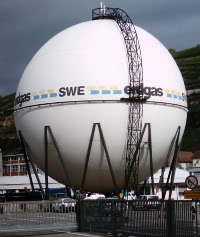NOW on PBS – Fracking, Natural Gas, and Renewable Energy


Yet I took exception to David Brancaccio’s NOW this week, in its gross oversimplication of the migration to renewables. In an attempt to inflame the viewer about the dangers of fracking (hydraulic fracturing, injecting water and chemicals deep underground to pry out gas locked away in tight spaces), the show told its views flatly, “We have renewable energy technology right now.”
At a certain level, this, of course, is true; there are a dozen or so clean energy technologies that are quite functional. But without context, this statement is horribly misleading. Sure we have the technology now, but there are hundreds of issues that many thousands of people are diligently working on — that will ultimately enable renewables to be deployed in an economically, legally, and ecologically sound way. As a friend of mine is fond of saying, “There’s plenty of clean energy if you don’t care how much you pay for it.”
If you want to stir up viewers, David, I would urge you to find a way to do so without feeding them a load of half-truths. I would say that to anyone — but especially to a man with a well-educated audience that can deal quite ably with the complete set of facts.

Having not seen the show, I’ll refrain from any commentary in that space. The notion that we can go directly to renewables is nonsense. I usually hear stuff like “next Manhattan project”. I do think it is laudable for people to care, and after all, that’s what the readers of this subject matter are most likely trying to accomplish – getting people to care.
Briefly, energy economies take 20-30 years to embrace a disruptive replacement to the previous paradigm. While some people might believe it is due to the intransigence of leadership, and I don’t discount this as a variable, it is mostly about the size of the problem and the inability of capital markets to accelerate on the largest problems. We may have gone to the moon, but that’s easy compared to moving trillions of dollars in a relatively short time.
My napkin calculation says that coal fired electricity is the largest segment of the problem. Call it 100 Q x 62% x 50% = 31 Quads or roughly 9 quadrillion Watt-hours (EIA 2010 ref model). My fave solar panel supplier (these days) gets me high quality panels at around $2.50 per Watt. First Solar can make them all day long at a profit, and sell them to the Chinese, for .80 per Watt. So lets use the lower number and assume 5 hours per day insolation on the average. If my napkin didn’t drop some digits, it looks to me like we need 1.8B MW installed x .80 per watt = $1.44 quadrillion dollars. Double that for the cost of installation (it’ll be more). Yeah, I know. I did a PV example. Turns out wind is cheaper to install, but when you get done with the utility calculations, its actually a more expensive investment. Also note I didn’t include energy storage costs.
Does anyone think that any amount of Manhattan can gin up a quadrillion Georges? And that’s just the coal fired electricity problem. We pretty much *have* to move through an interim fossil fuel solution while headed to renewables.
The betting person that I am, I see natural gas as being on the critical path. Where? Fuel cells. Natural gas is the lowest cost source of hydrogen for any FC technology, at around 16 to 20% of the cost of electrolysis. That pretty much determines the role of natural gas as related to FC’s, and FC’s might make a significant dent in the stationary generation of electricity in our efforts to replace coal. I’m not quite in Bloom Energy’s camp yet in terms of believing they’ve cracked the FC cost problem, but I am assuming we will make incremental progress.
Did you just say that Bill Moyers makes “an honest attempt to inform viewers in an objective and unbiased manner”?!? Wow! How do you feel about Rush Limbaugh’s unbiased objectivity?
The definitions for a quad of energy that I can find refers to 10 to the 15th power BTU’s. Since a kWh is equal to 3,413 BTU’s, then a Quad is equal to only 293 GWh. This should bring the costs well within reach.
Ok. Check me on this again. 31,000,000,000,000,000 / 3.413 = about 9,000,000,000,000,000 (quadrillion) watt-hours. I did all the napkin calc in watts, not kW, because the price of the PV was in per watt pricing when I divided it out at a cost of .80 per watt not installed. You could argue I should divide(multiply) by a higher number than 5 to get the watt-hours. I could argue that I should have factored in about 15% loss for system inefficiencies. Basically, a napkin calc.
Also, since we were only disagreeing by 3 orders of magnitude, I commend your optimism that $2.4 trillion dollars *is* doable.
I knew I was about to take a tongue-lashing for writing that Bill Moyers was fair and objective — and sure enough …
Craig,
When you look at the damage coal has done in Appalachia and the horrendous potential damage of fracking (in the NY watershed?????) it really becomes apparent that renewables are the way to go – even though they are not perfect the damage is considerably less.